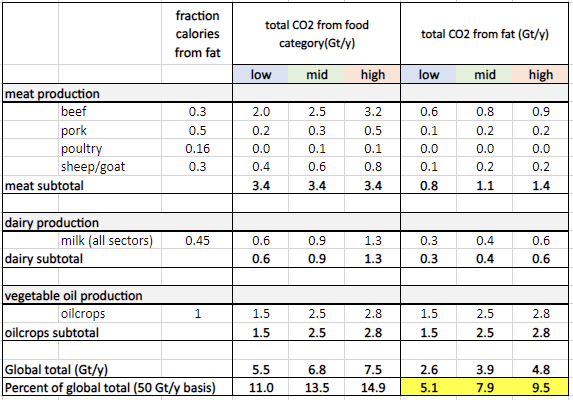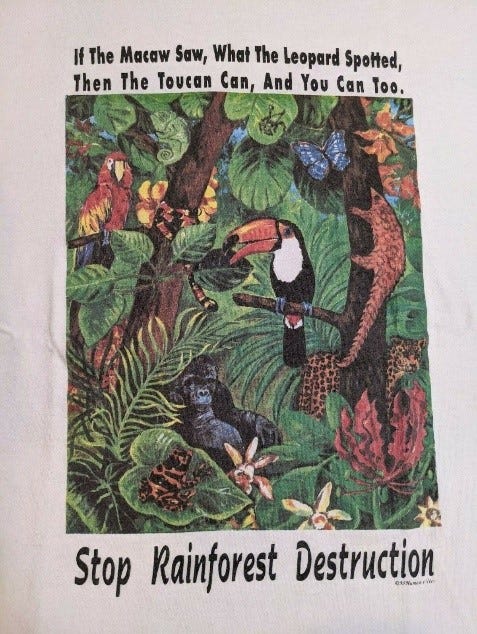How do we know fats account for 7% of all greenhouse gas emissions?
by Kathleen Alexander, co-founder and CTO
The Gates Notes blog recently posted about Savor and the importance of fat as a climate problem. In this post I’ll walk through fat as a climate problem in more detail.
“We make Fat.” I used to lead up to this with a lot more hedging and qualification, but these days when people ask me what we do, I just tell them “we make Fat” (I try to say it with a capital ‘F’ like that). It can take a few seconds to sink in, and if people look like they’re struggling to get it, then I might add in some helpful context such as “…the kind you eat!”
Though it’s not exactly the profession I envisioned for myself, making fat is far and away the most deeply motivating and interesting thing I’ve ever done—and the breadth and depth of reasons why continue to surprise me. There are ecological reasons: since our fats are produced in a factory from only water, energy, and carbon feedstock, they’d take up virtually no land or water compared to growing vegetable oils. There are the security reasons: since our fats are producible virtually anywhere and from a variety of feedstocks, our fats could get any nation to food independence, no matter the weather, and no matter who declares war. And, of course, there’s taste: the chance to make animal-free foods truly craveable. But today I want to focus on a different reason why: climate.
Climate is what got us interested in fats in the first place. Everyone knows that animal-based foods are an affront to the atmosphere. And some people know that the climate impact of plant-based fats is still staggering (between clearing land to plant crops, producing fertilizer, extracting the oils in large facilities, and then shipping them around the world, it adds up!). But exactly how bad are they?
We discussed in our previous post how we spent a lot of time examining the environmental impact of the food system, and how we eventually decided to commercialize a new approach for making fat because it had a higher technical readiness and potential for impact than anything else we’d seen. But we didn’t actually explain how we calculated this potential for impact, what that potential for impact is, or how all that convinced us that making fat was the most important thing we could imagine spending our time on. So that is what we are going to do here.
Here we go! How do you quantify the impact of fat production on global warming? Measuring the global warming potential of any product is not an easy task. For a chemical process like oil refining, the CO2 and other gases emitted during processing can be directly measured, and the quantities of these gases emitted for each barrel of oil produced can then be calculated. These measurements can be performed at virtually all oil refineries in the world and an average value for the carbon intensity of oil refining (i.e. the gCO2eq/bbl) can be determined. Does this carbon intensity have substantial uncertainty and vast regional variation? Absolutely. But as carbon accounting goes, this is about as simple as it gets.
Carbon accounting for agriculture is a much more complicated story. Ag emissions come from many different sources, including fertilizer production, fertilizer breakdown to N2O, running heavy machinery like tractors and grinders and stills, and release of gases like methane from crops and livestock—many of which are tough to measure. To further complexify matters, a large component of the carbon intensity of agriculture is due to land-clearing and land-use change. Forests and soils can store large amounts of carbon, much of which gets emitted to the atmosphere when land is converted for agricultural use. This results in two distinct challenges: How do we measure the shift in stored carbon? And how do we count it?
The measurements include a combination of: forest inventory data, remote sensing data, and average forest biomass per eco-region, which is derived from forest density maps and sample data. Put it all together and you can estimate the agriculture-driven deforestation emissions, or ADD1:
In terms of accounting, it is typical to amortize land-use change emissions over 20 years. This introduces some interesting artifacts in analyzing the carbon intensity of food production, because it means we may report the carbon intensity of food produced on two similar fields to be substantially different because they were established at different times, even if the produced emissions and carbon-storage potential of the land are the same. This effect is quite pronounced in the analysis in Figure 2 of our Food without Agriculture paper.
Big fat impact. So where does this leave us if we want to quantify the contribution of global fat production to global warming? Fortunately, large armies of scientists have been compiling agricultural production emissions and land-use change measurements for decades. Only slightly smaller armies have built and tested models to analyze and interpret these measurements2. Much work has then followed to agglomerate and analyze this rich set of data. In 2021, our colleague Chaopeng published “Global and regional drivers of land-use emissions in 1961–2017”3, in which he and his coauthors present a bottom-up accounting of total world agricultural emissions. Their Table 1 summarizes the per crop contributions to anthropogenic GHG emissions:
While there are other analyses like this which give similar overall answers, several things make this one especially useful. It’s recent and builds on recent datasets; it analyzes many food categories so you can compare it to other work; it includes land-use-change emissions (not all do); and most importantly it sums up all agricultural emissions in a way that’s consistent with those reported by the IPCC. This last point is particularly relevant, because if we would like to evaluate the relative contribution of various sectors to global warming, it is important to have a consistent denominator!
From an inspection of Table 1, you’ll see that we have most of what we need to figure out the contribution of fat to global emissions. In row 3 we see that oil crops alone account for 3.0-5.6% of total anthropogenic GHG emissions. However, fat is also a component of the calories in meat and dairy. So, to get the full scope of all emissions attributable to fat production, we have to add in the fat portion of meat and dairy emissions, which we can apportion on a caloric basis (see our table below). This results in a total of >7% of anthropogenic emissions that can be attributed to fat production4.
We summarize this graphically below, where we’ve also broken out the different dairy sectors individually5.
Is it big enough? We crawled down this rabbit hole because we said we wanted to accomplish three things: explain how we estimated the global warming impact of fat production, present the values we estimated for the GHG emissions attributable to fat production, and lastly, explain why we were convinced to start a company that makes fat in a new, very low-land use, very low carbon-intensity way. So we have made it to the third phase of this journey where we must ask whether this 7% number is big enough to make us care about Fat (…you know, the kind you eat)?
And not just care about it, we are going to have to be really obsessed with Fat. We will be dedicating years of our lives to this work. What does that number have to be to make it feel worthwhile? What if the number were 3%, or 12%6?
It turns out that for me, it’s not just about the number. Yes, 7% does feel ‘big enough’, but there are quite a few 7% pieces of the anthropogenic GHG emissions pie—almost all of which would land more smoothly than “we make Fat”. Automotive transportation, steel production, and cement production each contribute about 7%, as well. Much more so than fat, each of these are out there and widely appreciated as climate challenges worthy of our energy and attention. But the environmental impacts of fat production are devastating to a degree that is not fully represented by a number like 7%. The egregious and accelerating ecosystem destruction and biodiversity loss in regions uniquely suited to the production of oil crops is literally the stuff of my childhood nightmares (that logging machine from FernGully still gives me the creeps)7.
This is what sets the food system, and fat in particular, apart from other climate problems: if we are successful in commercializing our non-agricultural approach to fat production, we could capture an unprecedented opportunity to preserve existing forests and even rewild historic forestlands. I believe this mission is urgent and that there is a limited time horizon on which we can act. For me, that easily transcends a number like 7%.
So we’re making Fat — get excited!
S. Carter et al., “Agriculture-driven deforestation in the tropics from 1990–2015: emissions, trends and uncertainties,” Environ. Res. Lett., vol. 13, no. 1, p. 014002, Dec. 2017, doi: 10.1088/1748-9326/aa9ea4.
(We may not all be giants, but our collective bodies seem to have elevated the overall point of vantage…)
C. Hong et al., “Global and regional drivers of land-use emissions in 1961–2017,” Nature, vol. 589, no. 7843, pp. 554–561, Jan. 2021, doi: 10.1038/s41586-020-03138-y.
Yes, there is a non-zero amount of fat in pulses and grains, but those contributions are well in the noise here.
Dairy fat has high-value market opportunities for our company, Savor, so we often look at higher resolution in this space.
If behavioral economics is working, you will have a very predictable reaction to each of those numbers.










Cows poop. This poop fertilizes the land creating healthy and abundant grasses. Your models don't take into account the positive impacts of livestock. Allan Savory, Joel Salatin, and others have proven this.
Public perception of Bill Gates and anything he does relating to food is poison, and no one in their right mind would touch this stuff. How do you plan on combating this issue? or will it just be baked into the premade food we buy?